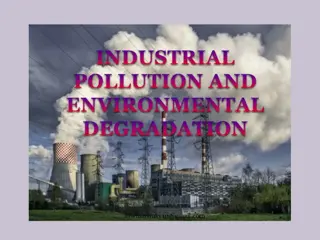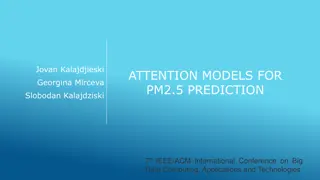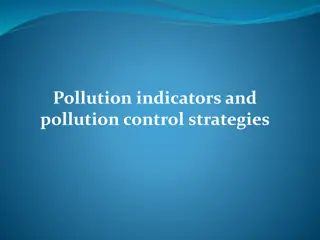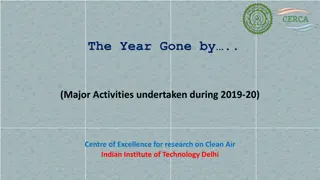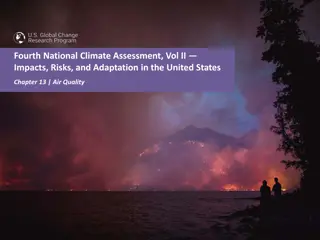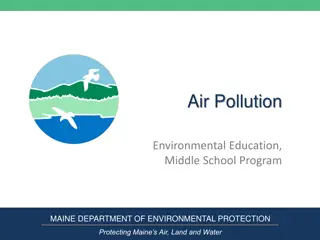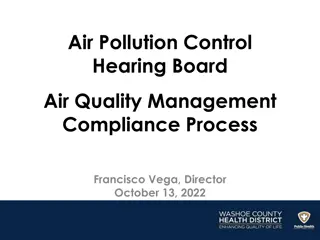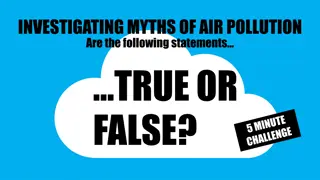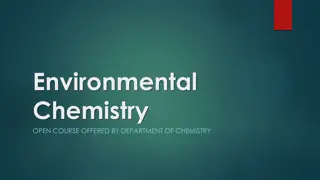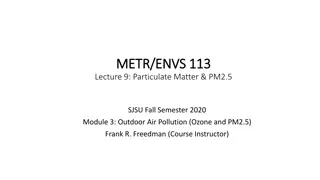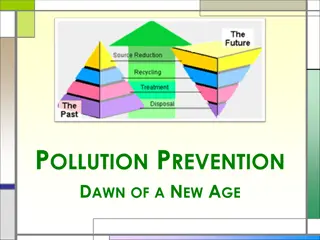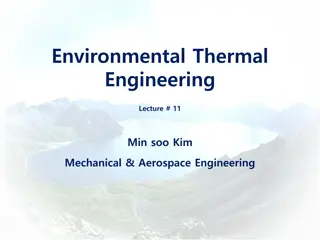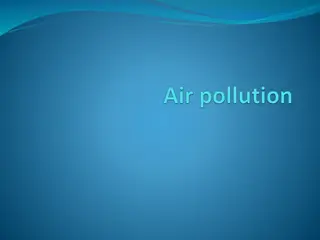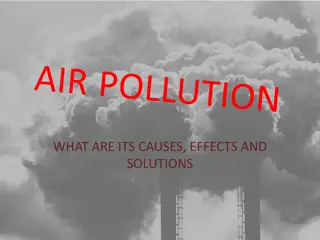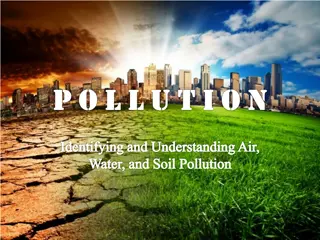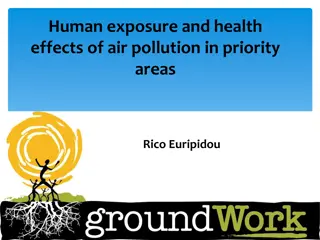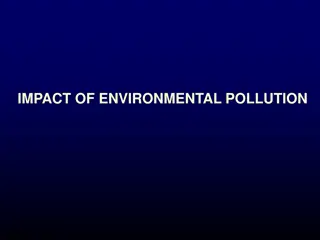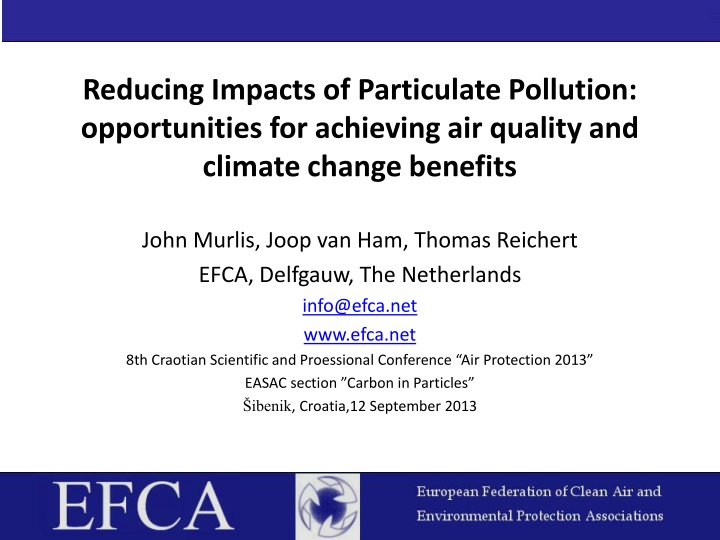
Reducing Impacts of Particulate Pollution: Opportunities for Achieving Air Quality and Climate Benefits
EFCA works to protect the environment, climate, and human health in Europe against pollution effects. Their initiatives focus on improving air quality, reducing black carbon emissions, and aligning air pollution and climate change policies. Through conferences, symposia, and policy discussions, EFCA collaborates with member associations to advance sustainable development and professional activities.
Download Presentation

Please find below an Image/Link to download the presentation.
The content on the website is provided AS IS for your information and personal use only. It may not be sold, licensed, or shared on other websites without obtaining consent from the author. If you encounter any issues during the download, it is possible that the publisher has removed the file from their server.
You are allowed to download the files provided on this website for personal or commercial use, subject to the condition that they are used lawfully. All files are the property of their respective owners.
The content on the website is provided AS IS for your information and personal use only. It may not be sold, licensed, or shared on other websites without obtaining consent from the author.
E N D
Presentation Transcript
Reducing Impacts of Particulate Pollution: opportunities for achieving air quality and climate change benefits John Murlis, Joop van Ham, Thomas Reichert EFCA, Delfgauw, The Netherlands info@efca.net www.efca.net 8th Craotian Scientific and Proessional Conference Air Protection 2013 EASAC section Carbon in Particles ibenik, Croatia,12 September 2013
Overveiw EFCA Identity, Mission, Activities Policy initiatives: One Atmosphere Particulate Pollution and black carbon Sources and management Comparison of metrics Vehicle regulation Conclusions
What is EFCA? European Federation of National Associations Mission To help to achieve policies and measures that will protect the environment, climate and human health in Europe against the effects of pollution while fostering sustainable development
Membership Full Members CAPPA, Croatia FAPPS, Finland APPA, France KRdL, Germany GUS, Germany CSIA/ATI, Italy VVM-CLAN, Netherlands PIGE, Poland SCAS, Sweden Cercl Air, Switzerland TUNCAP, Turkey EP-UK, United Kingdom Associate Members IUAPPA (International Union of Air Pollution and Environmental Protection Associations) NILU, Norway Observers ASASPP, Austria
Activities Conferences, organised by members Symposia Policy initiatives Forum discussions Newsletter, website (www.efca.net) Furthering professional activity: mutual assistance between Members
Policy Initiatives 1. Improving the effectiveness of CAFE. December 2004. Recommended approaches, in addition to the system of air quality limit values to improve health protection in Europe. 2. Linking air pollution and climate change - a challenge for European legislation. 2010. Showed inconsistencies between air quality and climate change legislation in the EU. Recommended improvements for Directives. 3. Black Carbon Particles (BCP): Opportunities to strengthen policies on Air Quality and Climate Change in Europe". Proposal to include Balck Carbon Particles as an additional indicator for the protection of human health. Connects this with the need to reduce the emissions of Black Carbon to reduce global warming.
Overarching Theme EFCA s overarching theme is One atmosphere , endorsed by EU Commissioner Janez Poto nik One message that has been hammered home this year is "only one air". We all share the air we breathe, and we need to share global solutions .. EU air quality policy, above all in the transport sector, is used as a reference model for air pollution strategies in many other parts of the world. As well as a responsibility, this also represents a huge opportunity, and we need to make sure that European leadership will give the right direction. EU Green Week Closing Speech 7thJune 2013
One atmosphere - Particulate matter EFCA Activities Conferences on Integrated approach on clean air and climate (2008; 2011): furthering cost-effectiveness Policy Initiative Linking air pollution and climate change (PI-2, 2010) Symposium series on UFP (2007, 2009, 2011, 2013, ..) Metrics session at UFP-3 (2011); proposal from the scientific community for Black Carbon Particles as additional metric, next to PM10/PM2.5 Forum discussion at www.efca.net (2011/2012): what about Particle Numbers? Policy Initiative on Black Carbon Particles (PI-3, 2012)
Recommendations PoIicy Initiative-2: refer in air quality legislation to climate objectives (in 2010 missing in EIA-, IE- (former IPPC), NEC- and AQ-Directives): EIA Directive and energy efficiency IE Directive and Bref s NEC Directive and AQ Directive Policy Initiative-3: include BCP (not PN) as additional metric in the Air Quality Directive: serves clean air and climate objectives and facilitates its implementation
Why a Black Carbin Particulate metric? Political consensus: keep warming below 2oC temperature rise: essential to curb emissions of CO2-and F-gases which have long atmospheric lifetimes But no political consensus on actions to achieve this Action on Short-Lived Climate Pollutants (Ozone, Methane, Black Carbon) may buy time BC is major climate forcer (WMO-UNEP, 2011; Pont et al, 2013) and responsible for 0.5-1.1oC warming in NH Political consensus: Particulate Matter (PM) is a major factor in health impacts of air pollution BC therefore controlled through AQ legislation as component of Particulate Matter: considerable potential for further actinon
WHY BLACK CARBON? MAGNITUDE OF GWP OF BC RELATIVE TO CO2 IPCC data indicates GWP (20) of BC to be 1600 and GWP (100) 460 but engine-derived soot has higher GWP than other forms Jacobson (2009) GWP (20) of fossil fuel soot about 2500, GWP(100), 865 to 1255 Direct-effect GWP of BC, relative to CO2mass Bond and Sun 2005.
WHAT IS BLACK CARBON? Combustion of all kinds produces pollution: solid, including carbonaceous particles, sulphates and nitrates gaseous, including SO2, NOx, CO2, CO, Black carbon (BC) is the carbonaceous fraction of the particulate emission from combustion Particles of BC are typically small (less that 1 m in diameter, known at PM1.0) and come in many forms: Charcoal Tar Soot All have the key property of absorbing energy from solar radiation Note: EFCA UFP 2013 Presence of high quantities of non-combustion components in UFP - tyre, road surface
WHERE DOES BLACK CARBON COME FROM? fires from burning biomass (agriculture, forest clearance) Industry (incomplete combustion of fossil fuels) Residential: heating and cooking Diesel IC engines (transport and non-road) contribute nearly 25% Non-road about 40% of diesel BC emission Note EFCA UFP 2013: marine sources emerging as important new factor
WHERE DOES THE BLACK CARBON COME FROM? SOURCES AND GEOGRAPHIC DISTRIBUTION EU emissions remain significant, despite historic reductions (IIASA 2007) In regions where agricultural burning is controlled (Europe, North America), diesel higher proportion of total (>50%) Europe is a major source of diesel-derived black carbon Note: importance of off-road and, not included, ships
BLACK CARBON REDUCTION TECHNOLOGY For developed countries control of diesel BC would have significant effect Current focus: diesel vehicles Diesel Particulate Filters (DPFs) reduce BC in diesel exhaust by 99% Currently widely fitted to new passenger cars, HGVs and Buses BUT further opportunities Retrofit to diesel in current road transport fleets Construction and other non-road vehicles and machinery
UK: Double Decker Bus Fleet
Estimate of global warming potential of PM from a Euro III bus over representative drive cycle (MLTB) Double deck bus, assuming: PM emissions of 0.35g/km Estimated 75% carbon = 0.26g/km CO2emission of 1500g/km Estimate of GWP (20) = 2500, BC is 30% of total climate impact Low estimate of GWP (100) = 1000, BC is 15% of climate impact 1.5kg/km CO2eq to 120 tonnes CO2/yr at 80,000km/yr or 1200 tonnes CO2over 10 years Fitting DPF is equivalent to saving of between 210 and 525 tonnes CO2over 10 yrs or up to 44% of fuel consumption At a cost of 2500/DPF, the cost of removing the eq of 1 tonne CO2is 5 - 12 per tonne (or 17 - 44 per tonne of C) Competitive with Carbon Capture and Storage ( 30 to 60 per tonne C)
Incorporating BC in EU Legslation Do we have the evidence for the AQ impacts? Requires elements of an air quality model Dose-response relation from epidemiological studies, in particular excess mortality EU-wide emission inventory Validated model: emissions - monitoring data Scenarios Economic module Costs of emission reductions required to reduce (part of) excess mortality Monetarising benefits of reduced excess mortality
Feasibility for PM, BCP and PN PM2.5 BCP PN Concern + + + Dose-effect relation (short term effects) + + +/- Dose-effect relation (long term effects) + +/- - Emission inventory + +/- (+/-) Monitoring data + +/- - Source specific - + - Co-benefits with climate objectives ? + ? + available; +/- incomplete; (+/-) scarce data only; - data absent
EU Vehicles regulation EURO VI Regulation for heavy vehicles: Emission limit value for Particle Numbers (PN) Helpful against global warming? Quantifying health benefits? Will it protect public health? Uncertain Presently impossible Certainly: no regret Hypothesis: Limiting PN-emissions reduces BC-emissions Need for robust relation between BC- and PN-emissions knowledge gap for air quality policy?
International Dimension IUAPPA, (EFCA is a regional member) a partner in the UNEP Climate and Clean Air Coalition : UN CCAC UNCCAC: 34 UN members in partnership 36 non-state Partners Scientific Committee Objectives : address short lived climate pollutants by: Raising awareness Enhancing and developing new national and regional actions Promoting best practices Improving scientific understanding
Conclusions 1. An integrated policy approach on air quality, climate and transport in EU would further cost-effectiveness; requires urgent attention 2. Specific regulation on BCP and/or PN are no-regret options 3. BCP regulation is the preferred additional metric 4. However, knowledge gaps include: Dose-response relations for long-term health effects of BCP and for short-term and long-term health effects of PN Databases of emissions and monitoring data of BCP and PN Robust relation between BC-emissions and PN-emissions 5. EFCA ready to play a significant role
EU Commissioner Janez Potonik Green Week Closing Speech One message that has been hammered home this year is "only one air". We all share the air we breathe, and we need to share global solutions .. EU air quality policy, above all in the transport sector, is used as a reference model for air pollution strategies in many other parts of the world. As well as a responsibility, this also represents a huge opportunity, and we need to make sure that European leadership will give the right direction.

